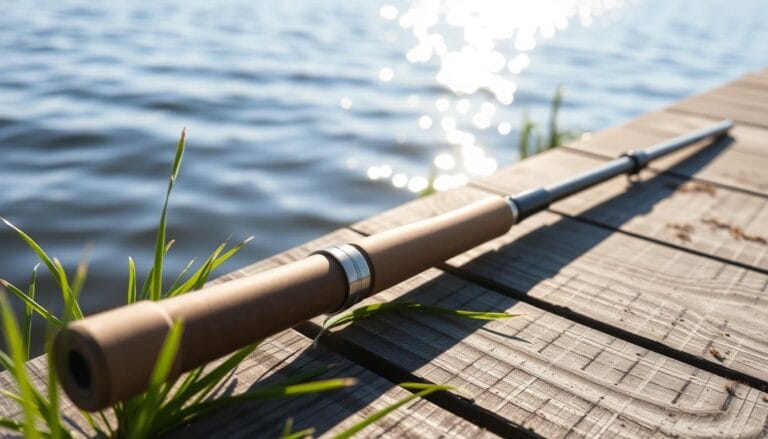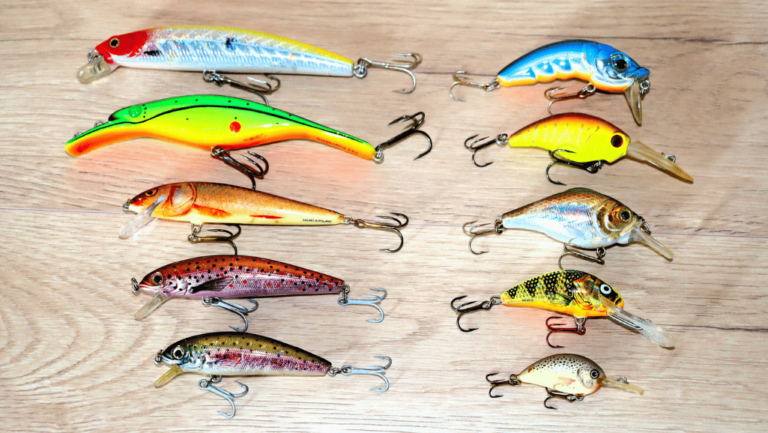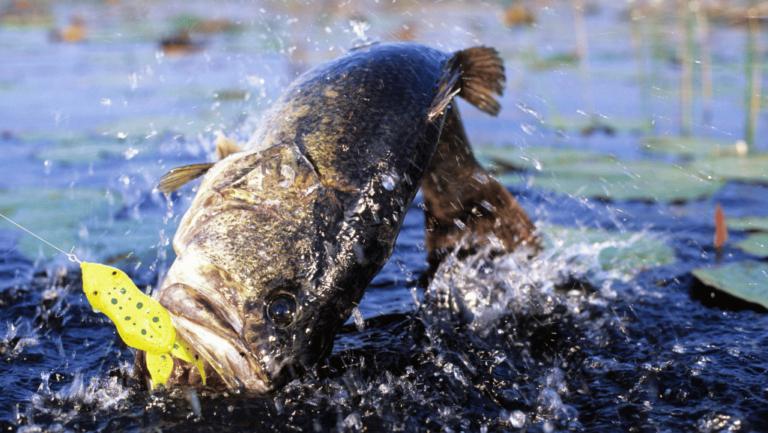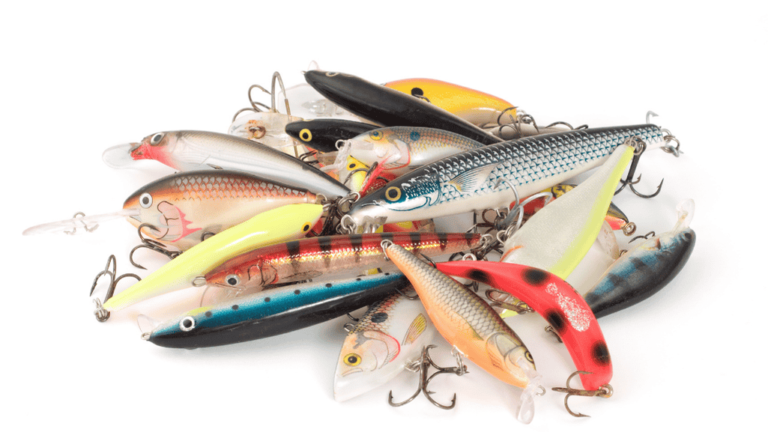In the exciting world of bass fishing and freshwater fishing tactics, choosing the perfect fishing lure is key. It can mean the difference between catching a lot of fish and not catching any. Jerk baits vs crank baits are two popular choices among fishermen for good reason. Understanding their special features and when to use them can really boost your chances of reeling in a big one.
Let’s take a closer look at jerk baits and crank baits, focusing on what makes them different. We’ll check out how they’re made, how they move, and the best times to use them. Knowing all this helps anglers choose the right bait for each fishing adventure, making them more successful.
Key Takeaways
- Jerk baits and crank baits are key in catching bass.
- Jerk baits act like injured prey, moving in a crazy way.
- Crank baits dive down and wobble, catching the eye of fish.
- Each bait is great for certain fishing spots and conditions.
- Picking the best bait means looking at where you’re fishing and what fish you want to catch.
Understanding Jerk Bait
Jerk baits are a must-have for fishermen, known for their smart design and how well they work in different fishing spots. This part will get into why jerk baits stand out and share tips on using them well.
Design and Structure
The main point of jerk baits is their slim, lifelike shape. This shape moves like an injured fish, catching the eye of hungry fish. They’re usually made light from plastic or wood, with bright finishes to sparkle in the water. Some even have rattles to make noise and draw more fish.
Optimal Fishing Conditions for Jerk Bait
To get the most out of jerk baits, you need to know the right spots and times. They’re best in clear, cool waters where their realistic looks and slow movements work best. Remember, the weather and how clear the water is can really change how well they work.
Understanding Crank Bait
Crank baits are key items in any angler’s gear. Their special design works well in many fishing situations.
Design and Structure
Crank baits float and have a diving bill that helps them dive when you cast them. This creates a captivating movement underwater that fish find hard to resist. There are many types of crank baits. They vary in size and shape to suit different fishing needs, which is why both pros and beginners like them.
Optimal Fishing Conditions for Crank Bait
For the best use of crank baits, think about the water’s depth, what the bottom is like, and if there’s a lot of vegetation. These things matter a lot. Crank baits are great for catching fish that hang out in deeper spots or near things under the water. They’re also good at luring fish out of thick plants. This makes them a smart addition to your fishing supplies.
- Water Depth: Use crank baits when you want to reach fish in deep water or places that are a bit harder to get to.
- Bottom Structure: In lakes with rocky bottoms or structures, crank baits can look like fish prey and help you catch more.
- Vegetation: They’re perfect for spots with lots of plants under the water, as their motion can attract fish out.
| Condition | Benefits |
|---|---|
| Water Depth | Targets fish at various depths |
| Bottom Structure | Mimics prey along structured areas |
| Vegetation | Entices fish out of dense cover |
Jerk Bait vs Crank Bait: Key Differences
Anglers often discuss the differences between jerk baits and crank baits. The big focus is on how they move in the water. Jerk baits and crank baits act very differently, and this affects how well they catch fish in various situations.
Action and Movement
Jerk baits move in an uneven, darting way, just like a fish that’s hurt. This can make the fish in the area think it’s an easy target. Anglers use a technique of pulling and stopping the bait. This makes it more attractive to fish.
In comparison, crank baits have a smooth, back-and-forth motion thanks to their unique shape. This motion is great for covering a lot of water or reaching fish at certain depths. They are pulled steadily, creating a reliable movement that fish find very tempting.
Target Species
Both jerk baits and crank baits attract different kinds of fish. Jerk baits work well for bass, pike, and walleye. They look like they’re easy prey, which really excites these fish to bite.
On the other hand, crank baits work best for fish that live at specific depths. This includes bass, crappie, and catfish. Their diving ability lets anglers target these fish hiding deeper or under structures.
| Characteristic | Jerk Bait | Crank Bait |
|---|---|---|
| Fishing Lure Action | Erratic, injured prey | Steady wobble |
| Target Fish Species | Bass, Pike, Walleye | Bass, Crappie, Catfish |
| Retrieval Technique | Stop-and-Go | Constant Speed |
Fishing Techniques for Jerk Baits
Using jerk baits well can boost your fishing game. It’s all about knowing how to move the bait right. You want it to act like a wounded fish. This makes it a tasty target for big fish. We will look at how to use jerk baits and their retrieval methods.
Retrieval Methods
Good jerk bait fishing involves moving the bait like a hurt fish. There are a few ways to do this. Let’s look at some top methods:
- Twitching and Pausing: Start by twitching the rod for quick, jerky motions. Then, let the bait pause. This makes it seem weak and easy for fish to go after.
- Snapping and Jerk-Pause: Snap your rod to sink the lure to the right depth. Jerk it with pauses to look real to the fish.
- Slow Retrieve: Fishing in cold weather? A slow and steady pull can work wonders. It gives fish more time to decide to bite.
When to Use Jerk Baits
Choosing the right time to use jerk baits is key. They work best in certain situations. Here are a few of those:
- Cold Water: Jerk baits shine in cold water. They tempt fish to come close without moving too much. This gives fish the chance to grab it.
- Clear Water: Their lifelike moves are perfect in clear water. Fish see them well and are more likely to strike.
- Suspended Fish: It’s hard to catch fish in the middle of the water. Jerk baits stay at the right depth, making them great for this.
For more tips on using crankbaits and jerkbaits in various settings, visit this guide on when to fish each.
| Condition | Best Jerk Bait Technique |
|---|---|
| Cold Water | Slow Retrieve |
| Clear Water | Twitching and Pausing |
| Suspended Fish | Snapping and Jerk-Pause |
Fishing Techniques for Crank Baits
To really use crank baits well, you need to know a lot about how to fish with them. This includes different ways to move them and when it’s best to use them. Let’s dive into key fishing methods to get the most out of your crank baits.
Retrieval Methods
Varying your crank bait’s speed and rhythm imitates how prey moves naturally. Try retrieving them slowly and quickly to see what works best. A constant speed produces a steady wobble. Pausing now and then makes it seem like the baitfish is hurt. This can make fish more likely to bite.
- Steady Retrieve: Keep the same speed to make the crank bait wobble nicely. This is great for exploring large areas.
- Stop-and-Go: Stop reeling at times to copy an injured fish. This can attract predator fish more.
- Burn-and-Kill: Reel in quickly, then stop suddenly. This action copies a panicked fish. It can get quick bites from nearby fish.
When to Use Crank Baits
Knowing the right time to use crank baits is key. They work well in different water depths and conditions. This lets fishermen pick the perfect crank bait for each fishing spot.
- Shallow Water: Pick a crank bait with a small bill for shallow, weedy areas. It helps avoid getting caught up.
- Deep Water: Use a crank bait that dives deep for fish in the lower water layers. This is perfect for fishing in deep lakes.
- Weed Beds and Structures: Choose a crank bait with a medium bill for places with a lot of plants and structures under water. This method is flexible yet powerful.
By using these techniques and the right kind of crank bait for each situation, you can get better at fishing. Learning how to move crank baits and when to use them boosts your fishing abilities. This means more catches and better fishing trips.
Jerk Bait vs Crank Bait for Bass Fishing
In bass fishing, choosing between jerk bait and crank bait is key for better catches. Knowing what makes each lure work helps fishermen decide better. We explore why certain baits might be more attractive to bass.
Why Bass Prefer Jerk Baits
Jerk baits are great because they move unpredictably, like hurt prey. This makes bass think it’s a good meal and they bite. They work best in clear, shallow waters. Bass can see them well there. Jerk baits also work in colder water, which is great for fishing in fall or spring.
Why Bass Prefer Crank Baits
Crank baits dive down and float back up, letting you fish at different depths. This is perfect for fishing deep where bass like to hide, especially near cover or plants. Their side-to-side movements catch the bass’s eye. They’re known to be very effective in dark or murky waters.
Each bait, jerk or crank, has its own advantages. Knowing when to use them will make your bass fishing trips more rewarding.
Topwater Lures: Jerk Bait and Crank Bait Comparisons
Fishing with topwater lures is thrilling. Anglers see fish leap out of the water to grab the bait. Jerk baits and crank baits are both great choices, each for different reasons. This makes fishing more fun and effective, depending on the water and your style.
Effectiveness in Various Water Conditions
Topwater lures work best in certain water types. Jerk baits shine in still waters. They move in a random way, just like a fish in trouble. This attracts big fish looking for an easy meal. Crank baits, on the other hand, do well in rough water. Their steady swim and vibrations make them stand out, even in choppy seas.
Topwater Strategies
Having the right plan is key to catching fish with topwater lures. If you’re using jerk baits, move them with a twitch-pause tactic. This looks like a wounded fish, bringing in predators. For crank bait fans, a smooth, even pull is best. It keeps the bait moving right, tempting fish to strike. Knowing how to use each lure correctly can make a big difference. It can make your fishing trips more successful and enjoyable.
Choosing the Right Rod and Reel for Jerk Baits
When you’re into jerk bait fishing, your choice of fishing gear matters a lot. For this type of fishing, getting the perfect rod and reel combo boosts your control and success with bass fishing.
It’s best to use a medium to medium-heavy rod that’s fast. This type of rod helps you twitch your lures well and feel bites easily. A rod that’s 6’6″ to 7′ long is great for casting far and moving quickly.
A baitcasting reel with a fast gear ratio, between 6.3:1 and 7.3:1, is perfect. This kind of reel lets you reel in your line quickly. It also needs to have a drag system that’s smooth to handle bass’ strong runs.
Choosing the right fishing line is crucial, too. Many choose fluorocarbon line for its near invisibility and sensitivity. Others like to use braided line with a fluorocarbon leader for more strength and flexibility.
In the end, the perfect fishing gear helps you serve jerk baits just right. Your every twitch and movement mimics how wounded prey acts. This draws bass in, making every cast a chance for action.
Choosing the Right Rod and Reel for Crank Baits
Choosing the right fishing gear is key for successful crank bait fishing. Look for a rod with the right amount of power and action. A medium or medium-heavy rod with moderate action is great. It gives you the flexibility and feel needed for those light bites.
The reel is just as important. The gear ratio matters a lot. A lower ratio like 5.4:1 helps with deep-diving cranks, offering more power. For shallower areas, a higher 7.1:1 ratio is better, giving you a faster pull. The key is finding the right balance for your fishing needs.
| Specification | Details |
|---|---|
| Rod Power | Medium to Medium-Heavy |
| Rod Action | Moderate |
| Reel Gear Ratio | 5.4:1 for deep-diving, 7.1:1 for shallow water |
It’s also important to ensure your rod and reel work well together. Fishing can be tough on your hands and arms over time. By making sure your gear is balanced, you make fishing with crank baits a better experience.
Conclusion
In this article, we dug into what makes jerk baits and crank baits special. We talked about why their designs and fishing conditions matter. Both these lures can really boost your bass fishing. Jerk baits move oddly, looking like injured prey. They attract fish hungry for an easy catch. Crank baits, on the other hand, dive to different depths. Their wobbly movement brings fish in, no matter the water type.
It’s key to know when and how to use these lures for the best results. It all depends on the water’s temperature, how clear it is, and the flow. If you want to be a better angler, thinking carefully about the type of fish you’re after will help. So will understanding the materials and build of these lures.
Jerk baits and crank baits each shine in their own way. What you choose depends on where you fish, what you’re aiming for, and your style. Share what you like in the comments, and think about joining our Insider Club. You’ll get special fishing tips, discounts, and the latest reports. Staying flexible and informed helps make your fishing trips more fulfilling and successful.













